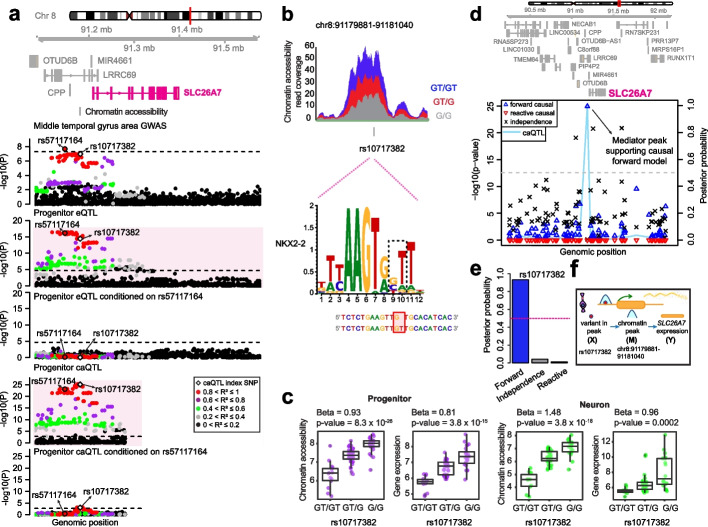Fig. 5.
Colocalization of shared ca/eQTLs at SLC26A7 locus with middle temporal gyrus area GWAS. a Genomic tracks illustrating regional association of variants with SLC26A7 gene expression, chromatin accessibility at its promoter, and middle temporal gyrus area GWAS. Colocalization of middle temporal gyrus area GWAS index SNP with shared ca/eQTL SNP was detected via conditional analysis. Data points were colored based on the pairwise LD r2 with the caQTL index variant rs10717382 within the chromatin-accessible region. The dashed lines correspond to p-value thresholds for significance for each dataset. b Coverage plot illustrating ATAC-seq reads within the chromatin-accessible region per genotype. Genomic position of the variant rs10717382 was shown along with the NKX2-2 TF motif disrupted by rs10717382. c Phenotype (chromatin accessibility and SLC26A7 expression) versus genotype boxplots per cell type. d Mediation scan plot overlaid with caQTL data for the causal forward model of epigenetic regulation of SLC26A7 expression in progenitors indicated by lines in different colors with corresponding p-value on the left y-axis, and the posterior probability of each possible model shown with different shapes on the right y-axis. The location of the peak supporting the causal forward model was highlighted. e bmediatR posterior probability for causal forward, independence versus causal reactive models for the regulation of SLC26A7 by chromatin accessibility. Posterior probabilities of causal reactive were set to zero by bmediatR since reactive model priors were not evaluated for mediation via chromatin accessibility. f The cartoon illustrating a causal forward model for the regulation of SLC26A7 by chromatin accessibility

